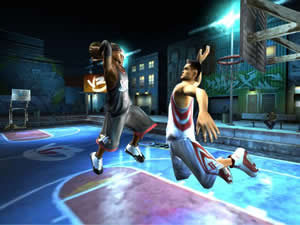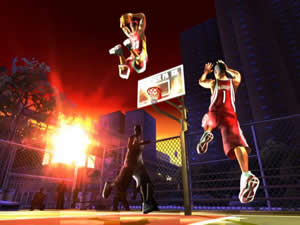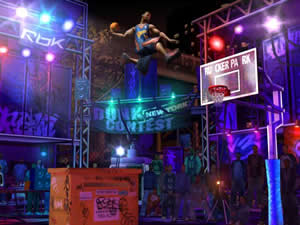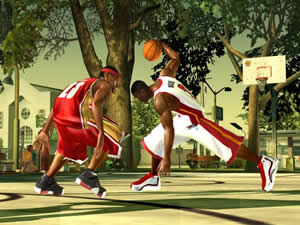I wish I was a baller.
As a short, geeky little kid in elementary school I was never good at basketball. I’d run as fast as I could and throw my elbows into the other players’ kidneys like my big brother told me to, but I found myself sprawled out on the asphalt more often than my shots found the net. Inevitably, I would always get picked for a team last. I thought that with age and height I might get better at playing ball, but instead I simply grew to look more and more like one. I had given up on anything other than living vicariously through my Sacramento Kings until I got my hands on EA Big’s new NBA Street V3.
NBA Street V3‘s big new features are the Trick Stick, some well-implemented gameplay refinement, improved dunking controls, online play, and a Slam Dunk competition. While some familiar gripes remain, NBA Street V3 is definitely the best package the Street series has seen yet, and one of the most entertaining basketball games on the market.
Two of the modes, Game On and Street Challenge should be instantly familiar to fans of the previous titles. Game On is your basic exhibition match, and Street Challenge is where your custom player and a rag-tag group of scrubs compete against other squads for enough reputation to make it into the official NBA Street League. Where previous Streets had separate street ball and NBA modes, NBA Street V3 brings them together. Now your custom character and your favorite NBA players can be on the same team, which is the way it always should have been.
To start out, you’ll use an impressively detailed character creator to build your team captain. You can adjust size, weight, eye width, nose slant, and all manner of other interesting little details. In a thoughtful touch, your captain’s size will affect the way he is able to increase attributes. For example, if you make a little guy, then handles and quicks will come cheap, but if you make a hulk, upgrading those qualities will be much more costly. Alternately, big players can upgrade attributes commonly associated with size more easily. This method makes a lot of sense and fosters a rational distribution of points without forcing you in any particular direction.
Once you’ve given your character a big nose, squinty eyes and a pointy chin, you’ll need to choose a location for your home court and decorate a little bit. However, there is only one currency in the game, Style points, and it is split between upgrading your player’s attributes, buying him bling, and decking out your court. As a result, it was hard for us to justify ever spending points on new rims, banners, and gold chains when we could be jacking up our Dexter Doozey’s rebounding and dunking skills. It would make much more sense if a time-based scheme like the one found in ESPN NFL 2K5 were use to enhance attributes, while the court and bling could be purchased with money won during tournaments and competitions.
That’s because there really isn’t any reason to deck out your character or decorate your home-court. Sure, saving up credits and buying cool-looking stuff appeals to the collector in us all, but your team won’t start bitching about pot-holes if you don’t drop any money on court maintenance, and girls won’t shun your playa even if you dress him in orange sweats and red Chuck Taylors, since, well, there aren’t any girls.
Attributes are some of the only things you can spend money on that affect the way the game is played, but these qualities are only meaningful relative to the other players on the court. And since the players on the court get tougher as you advance through the Street Challenge, attribute points are really just a means of maintaining the status quo. So while there are plenty of competitions to take part in, there really isn’t anything to manage off the court.
You can also spend points to pick up players from other squads. There isn’t too much strategy involved here, though, as you pick up some obvious marquee players pretty early on. There is room for strategic line-up changes, since some events will focus on the shooting game, while others will be dunks only. But when you make your captain a Shaq-clone, and then get Steve Francis and Paul Pierce you won’t ever need to think about how your players stack up, because they’ll all be able to do everything.
 The Street Challenge is well done in that it throws multiple events your way at the same time, and lets you choose between them based on the kind of mood you’re in. It is poorly done, however, in that you wind up playing and dominating the same exact events literally dozens of times. Since there isn’t anything to micromanage, the Street Challenge becomes a tedious game of repetition after several hours.
The Street Challenge is well done in that it throws multiple events your way at the same time, and lets you choose between them based on the kind of mood you’re in. It is poorly done, however, in that you wind up playing and dominating the same exact events literally dozens of times. Since there isn’t anything to micromanage, the Street Challenge becomes a tedious game of repetition after several hours.
Allegedly, there is a morale system that dictates whether or not players will want to join your team if you’re winning, and leave your team if you’re losing. But this system is hardly noticeable. The only aspect of it that got my attention was the way the same player kept on asking to join our team with the exact same message, even though we’d cut him for better players three times.
I became thoroughly tired of the Street Challenge after about 70 games. Of those, all could be divided into five rough types: regular games to 21, games that were won on the first game-breaker, games where only dunking scored, games without trick points, and Slam Dunk competitions. If that was all dutch to you, then let us put it more simply: there are long games, medium games, and short games. Of the five, only one type wasn’t much fun – the slam dunk competition.
In the slam dunk competition you compete against several other ballers all of whom are trying to accomplish extremely stylish, sophisticated dunks. All these really amount to though is taking off and pressing the R-stick in conjunction with some turbo buttons. Once you’ve taken your turn you have to wait for all the other competitors to dunk. You end up doing more watching than playing, and after you’ve tried it a couple times, you’ll probably abandon it for good.
The other four game types were good because they involved regular, Street gameplay. For the uninitiated, the Street games take an NBA Jam approach to basketball. You play three-on-three ball with spectacular dunks, crazy moves and an extremely intuitive, easy control scheme. Your shots, passes, dunks and jukes can all be augmented by pressing different combinations of the three turbo buttons (four on the PS2), and the trick stick can augment your jukes even further.
Instead of pressing a button to juke, NBA Street V3 has you press one of eight directions on the right-analog stick. Every trick can be modified by pressing one, two, or all three turbo buttons, meaning each player can execute at least 32 different moves. Since the PS2 version uses four turbo buttons, owners of that version will have forty different moves to play around with. On the other hand, Xbox owners will be forced to try and sink up the L3 button with the L and R triggers for their three turbo tricks, and that is not an easy thing to do. But at least two turbos are relegated to shoulder buttons across the board, so moving and juking feels natural, since you never have to take your thumbs off the analog sticks.
 The more turbos you use to perform a trick, the more stylish it becomes, and for every one you pull off before sinking a bucket or slam-dunking, you’ll get more Gamebreaker points. When you get enough of these points, you can execute a Gamebreaker with the proper button presses. Where most baskets count for a single point, Gamebreakers can count for up to four, as well as sap points from your opponent’s score.
The more turbos you use to perform a trick, the more stylish it becomes, and for every one you pull off before sinking a bucket or slam-dunking, you’ll get more Gamebreaker points. When you get enough of these points, you can execute a Gamebreaker with the proper button presses. Where most baskets count for a single point, Gamebreakers can count for up to four, as well as sap points from your opponent’s score.
When a gamebreaker begins, your player will launch himself into the air at which point you can bust fancy moves with the R-stick. Then, as you approach the rim, you can pass the ball off to another player for further tricks and greater points, assuming someone leaps into the air near you. This combo system is definitely an improvement over the Gamebreakers of yesteryear, however we wish the same variable dunk system had been applied to NBA Street V3‘s regular dunks.
After all, you can go up for a jam and then pass to another player while not in the midst of a Gamebreaker, and you can also change a dunk into a layup if you think you’re about to get blocked, but you can’t magically change a wind-mill into a reverse, or decide on the fly to throw in a spin move. It would also be nice if you could call-out plays. Most other basketball games allow you to coordinate with your players and devise basic strategies, but this element has never made its way into a Street game.
Still, NBA Street is fast-paced, kinetic and a lot of fun to play. Its control scheme is probably one of the most fluid we’ve ever seen, and while it isn’t deep in the conventional sense, you can bust so many crazy moves and maneuvers that even hard-core players will have a blast testing NBA Street V3‘s limits.
A large part of the game’s playability comes from its fluid animations and excellent graphics. NBA Street V3 benefits from fancy light-filters and good texture-mapping on every system, but the superb motion-capturing and hit detection are what makes blocking feel so right, and pump-faking defenders into the air before draining a three such an invigorating experience.
The music, although a bit repetitive, is light-years better than the crap that polluted NFL Street 2’s airwaves, and is welcome for its lack of machismo, and attention to funky beats. DJ Bobbito Garcia provides decent commentary whether you are winning or losing.
 The PS2 and Xbox versions are playable online through EA’s service with all its little perks like messaging and ladders. Here, you can play with the regular NBA teams or create a custom team with a created player. If you pursue the latter avenue you’ll win points by defeating opponents that can be spent on upgrading your custom Dirk LeDouches and Lazer Dazers. While playing against human competition brings out the very best in NBA Street V3, I was disappointed that you can only play against one human competitor at a time, rather than an awesome 3 on 3 matchup.
The PS2 and Xbox versions are playable online through EA’s service with all its little perks like messaging and ladders. Here, you can play with the regular NBA teams or create a custom team with a created player. If you pursue the latter avenue you’ll win points by defeating opponents that can be spent on upgrading your custom Dirk LeDouches and Lazer Dazers. While playing against human competition brings out the very best in NBA Street V3, I was disappointed that you can only play against one human competitor at a time, rather than an awesome 3 on 3 matchup.
The Gamecube version, in an attempt to make up for its lack of online play, also comes with three characters from the Super Mario Universe: Mario, Princess Peach and Luigi, who all play just like every other small player in the game. Unsurprisingly, these characters don’t fit NBA Street V3 very well.
NBA Street V3 could stand to be deeper in just about every area. However, for an arcade-style basketball game, that isn’t a serious gripe. Fun and accessibility are the most important factors for a game of this class, and the solid implementation of the new Trick Stick makes NBA Street V3 one of the most entertaining, broadly playable basketball games ever made. Plus, it’s impossible to get picked for the team last.
-
Sweet Trick-Stick
-
Awesome graphics
-
Fun and accessible
-
Deep online content
-
Shallow single player content
-
Can't call plays







